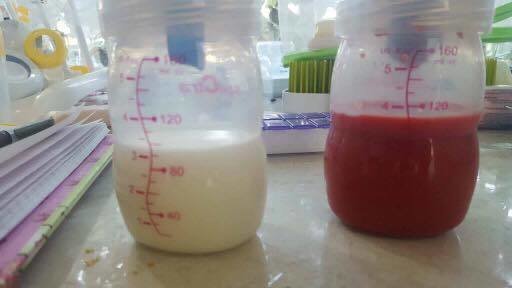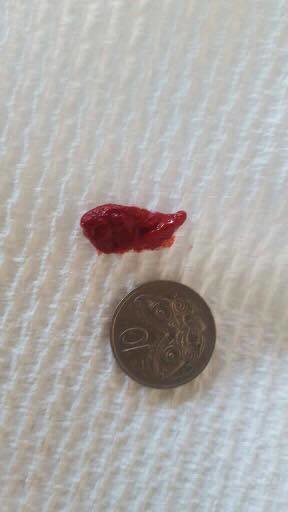
Just like giving birth, you don't truly understand the pain that comes with a clogged milk duct unless you've dealt with it. Despite the fact that an estimated 1 in 10 women in the US is diagnosed with mastitis — a clogged duct that turns into a serious infection — at some point during their breastfeeding journey, few get the chance to see how these clogs look and how they impact breast milk. That's why one mom decided to share photos of what her pumped breast milk looked like when she finally passed a bloody clot that almost turned into mastitis.
The anonymous mom shared her experience with lactation consultant Meg Nagle, who posted it on her Facebook page, The Milk Meg.

According to mom, this painful breastfeeding picture shows milk pumped after a bad clog that almost turned into mastitis.
"Amazing isn't it?! Yes, your milk may turn red, it may be infected, and it may look completely different from each breast … however it is still 100 percent safe (and awesome) for your baby!" Nagle wrote. "Do not stop breastfeeding from the affected side. If you have a clogged duct or mastitis it's important to keep breastfeeding frequently, apply heat and massage. If you are exclusively pumping then try to pump at least every couple of hours and massage, massage, massage. And don't be scared of how your milk looks!"
The mom also shared a photo of the giant clot she ended up passing.

"Passing the clot didn't hurt! I don't want people to be discouraged from pumping or breastfeeding during mastitis or plugged duct. Our bodies are amazing. I'm still exclusively pumping at 19 months so it certainly didn't discourage me!” she told Nagle. "I thought it might show what can happen to our milk that nursing moms might not usually see (I exclusively pump)."
The visual has left some shocked and wondering how it's safe for a baby to drink milk that looks like that.

"Can someone explain how this is safe to feed baby? I'm ignorant, and the blood/pus seems like it would make baby sick? Like how we feel sick if we swallow too much blood, etc.," one woman commented.
Many moms were quick to point out that it only takes a small amount of blood to dilute breast milk to such a vibrant hue, and the first thing you're supposed to do if you feel a blocked duct is actually to keep breastfeeding — even if it seems gross. According to the international breastfeeding organization La Leche League, "Antibodies in your milk will help protect your baby from any infection. Weaning from the affected breast is likely to make matters worse."
Many can't even imagine the pain this mom felt and are praising her for pushing through it.

"Ouch!!!! This makes my legs feel like jelly! Poor mama! I can imagine how hard it must have been to push through that!" one woman commented.
Others are sharing their own gems, because it's a truth that not all breastfeeding moms see.

"I use to get clogged ducts ALL the time. With my son I got mastitis 6x before I called it quits," this mom captioned her clogged duct photo. "This time I've only had it once, thank God!"
"This was my milk with mastitis. Bottom layer of pus ... Ouch," another mom shared.

The moms hope their photos inspire other women to pump or breastfeed through the pain — in order to help it. It's important for moms to understand that if something like this happens, it can be normal and isn't an immediate indication to stop breastfeeding. In many cases, it means just the opposite — moms should pump or breastfeed more to move the clog.
"Your commitment to breastfeeding your baby can be truly tested at times like this when putting your baby to the breast may be the last thing you feel like doing," it says on La Leche League's website. "However, continuing to breastfeed frequently is part of the solution and stopping suddenly is likely to make the problem a great deal worse."




